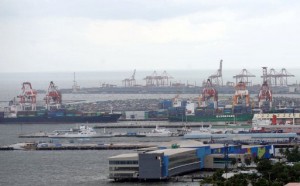Philippine economy grew 3.6-4% in 2011—NEDA

This 2009 file photo shows an overview of cranes loading ships with containers at the Manila South Harbor port. The Philippine economy, according to the National Economic and Development Authority, was estimated to have grown between 3.6 and 4 percent in 2011 due to, among others, sluggish exports. AFP PHOTO/TED ALJIBE
The Philippine economy, as measured by the gross domestic product (GDP), was estimated to have grown between 3.6 and 4 percent in 2011, according to the National Economic and Development Authority (NEDA).
In the fourth quarter alone, GDP grew faster than the third quarter’s 3.2 percent, but the expansion did not reach 5 percent, NEDA assistant director general Ruperto P. Majuca told the Inquirer.
Private economists, noting sluggish exports and typhoon damage to farm output in the fourth quarter, predict below-target performance for the Philippine economy when final GDP figures come out at the end of this month.
“Almost definitely, exports contracted,” Majuca said, citing challenges due to the debt crisis in Europe and the logistics disruption in Asia due to floods in Thailand. Agriculture might have also dropped “slightly,” Majuca said, due to floods and typhoons.
The National Statistics Office reported Wednesday that total imports growth slowed down to 0.6 percent for the second straight month in November last year to $4.98 billion from $4.96 billion in the same month in 2010.
Month on month, imports dropped 0.7 percent in November 2011 from $5.02 billion in October 2011.
Total trade for November 2011 was registered at $8.33 billion, down 8.5 percent from $9.1 billion in November 2010. The balance of trade in goods registered a deficit of $1.64 billion, higher than last year’s deficit at $810 million.
Electronics imports reached $1.38 billion, an annual decline of 14.9 percent. Semiconductors alone fell 18.6 percent from $1.32 billion in November 2010 to $1.07 billion last November, NSO said.
However, growth last year was believed to have come from the robust performances of the services sector and household consumption (supported by OFW remittances), and investments due to a “substantial increase” in public construction, Majuca said.
Private economists expected full-year growth of 3.7 percent, given that the economy might have grown just slightly higher than the third quarter.
Full-year GDP growth “will range from 3.7 to 3.9 percent,” said Cid L. Terosa of the University of Asia and the Pacific. Terosa said it was understandable for NEDA to be “cautious” since 2011 was a slow year for the economy and “they probably don’t want to fuel more anxiety.”
Benjamin E. Diokno of the UP School of Economics, however, said a full-year GDP growth of 3.7 percent might be “on the high side” given the expected contraction in agriculture on top of difficulties in exports.
The Department of Agriculture (DA) said in a statement Wednesday that agriculture grew 2.34 percent in 2011 with a drop in fisheries, which contributed a fifth of farm output, and small growth in crops, which accounted for about half of total production.
“This [2.34 percent full-year growth] implies that the sector contracted 3.7 percent in the fourth quarter,” Diokno said. If true, this development is a big blow to NEDA’s expectation that the economy grew 4 percent in the fourth quarter. “Faster government spending, if true, will not be able to offset such a sharp decline in agricultural output,” Diokno said.
The National Statistical Coordination Board, NEDA’s attached agency, is scheduled to report on January 30 the GDP numbers for the fourth quarter of 2011.
The NEDA has already said that typhoons might have cut 0.63 percentage point from the Philippine economy’s growth in terms of direct damage and lost productivity in 2011.
In the third quarter of 2011, both government and private economists were surprised when the NSCB reported a GDP growth of only 3.2 percent. The NEDA had predicted a range of 3.8- to 4.8-percent growth and private economists had forecast an average 4-percent expansion.
This was lower than the revised government forecast of 4.5 percent for 2011 and much lower than the “aspirational” 7- to 8-percent growth target.
The Aquino government wanted to achieve an average annual growth of 7 to 8 percent under the Philippine Development Plan 2010-2016 in order to curb poverty and generate “inclusive” growth.
